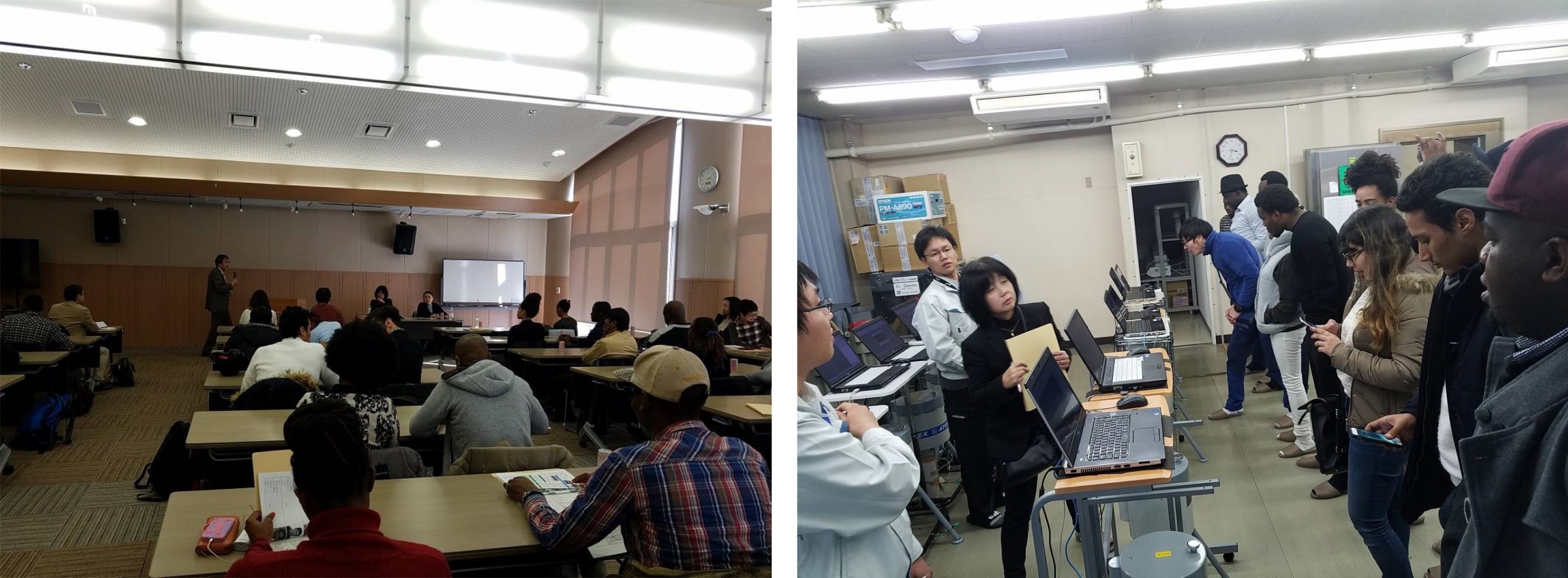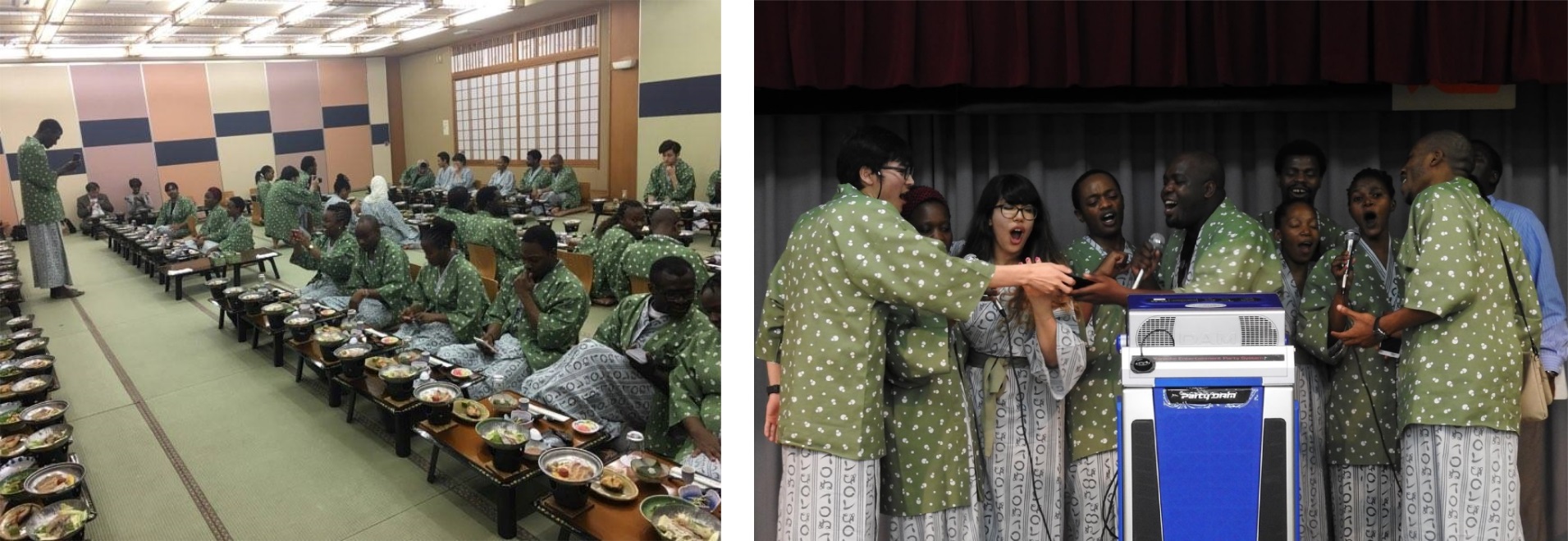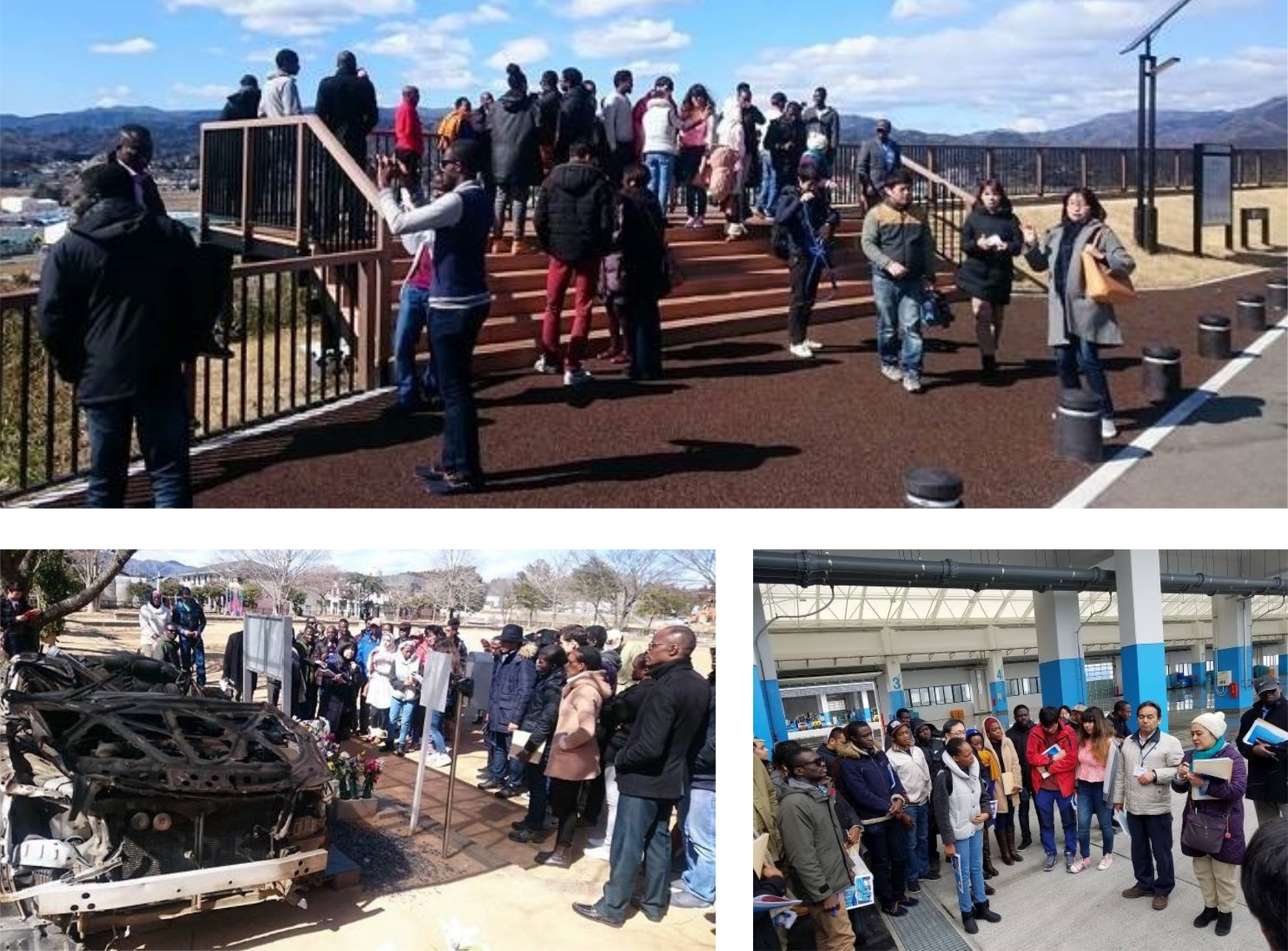The Fukushima Study tour was organized by the African Association of Miyagi (AFAM) in collaboration with Japan International Cooperation Agency (JICA) Tohoku Office from March 7 to 9, 2017. A total of 57 African foreign students from the Universities in the Tohoku region; namely Tohoku University, Miyagi University, Akita University and Yamagata University who are members of AFAM and at the same time with some of them under the sponsorship of JICA took part in this tour to familiarize themselves with the current situation of Fukushima after the Great East Japan Earthquake and the subsequent tsunami that devastated the coastal areas of the Tohoku region and triggered the accident of the Fukushima Daiichi Nuclear Power Plant. The program aimed at knowing the actual condition of Agriculture in Fukushima and learn about the safety of agricultural products in the area, touring the coastal area to learn about the situation of the victims’ evacuation, get understanding about the actual condition of the fishery activities and also, interact with farmers to know how they are overcoming the situation. The cooperating organizations were Fukushima Prefecture Consumers Co-operative Union, JA Fukushima Mirai, JF Fukushima Prefecture Fishery Co-operative and the Fukushima University. The tour arrangement was made by Co-op Travel Miyagi The study tour is part of AFAM’s planned activities to be carried out in 2016-2017 academic year.
Orientation Prior to the Tour
On March 6, at the JICA Tohoku office, orientation for the Fukushima study tour was held. Explanation of the tour schedule was given by Mr. Hatakeyama, JICA resource person, followed by a video overview of the Great East Japan Earthquake. Taken turns, Dr. Isaac Asiedu, President of AFAM also reminded participants about the importance of the tour and how the experience gained could be used. Presentations of campus life by students from Tsuruoka campus – Yamagata University, Akita University and the Miyagi University were also given as side program.
Day 1
The study tour effectively started on March 7, 2017 with two tourist buses, and by 8:30 am participants had already gathered at the Sendai station East entrance, the designated area for departure.

After travelling for an hour, we finally arrived at Fukushima city and received the first lecture entitled “Fukushima Daiichi Nuclear Plant Station Accident, its health Effects and Progress of countermeasures”, by Mr. Aoki Hitoshi, a technical advisor at the decontamination information plaza.

The essential lessons learned from this lecture are listed as follows:
- After the earthquake and Tsunami, 3,927 deaths were registered, agricultural facilities, housing facilities, public facilities (roads, buildings, educational facilities) were seriously damaged and other residential areas completely or partially evacuated. The prefectural government has started reconstruction activities to restore the lives of the victims.
- Based on a Scientific study, the effects of the nuclear disaster on the health of the affected people was almost negligible as only one thyroid cancer has been detected out of the 4,365 persons tested in Fukushima.
Ongoing countermeasures include: staying far away from radioactive materials; cleaning of tree bark; shortening exposure time/day (less than 1 millisevert/day), covering contaminated soil with 30 cm thick soil or by removing the surface soil of farmlands and replacing the contaminated soil with clean soil. In consequence, these countermeasures have successfully led to a significant reduction of the Cesium 137 concentration in Fukushima fruits (from 14 Becquerel/kg in 2011 to ~2 Becquerel/kg in 2014) and in the farmlands. Subsequently, a second lecture entitled “Agriculture in Fukushima after 2011” was given by Mr. Takano, Director of Marketing at JA Fukushima, an agricultural co-operative. The speaker stressed on the fact that after the nuclear disaster, the sales of Fukushima produced crops and foods (rice, persimmons, peaches, etc.) drastically declined and started suffering from reputational damages. In his words, he gave thanks to brilliant women’s sales initiative, the “Paddy project” aiming at growing rice from a famous river in Fukushima, the commercialization of the Fukushima rice was restored. The power of collaboration with consumer co-operatives nationwide, through advancing promotional sales of fruits and other food commodities also help to overcome the harmful rumors that affect the reputation of food items from Fukushima.

To promote the safety and quality of food products from Fukushima, continuous monitoring/inspection of all foods was initiated. In this process, food products before shipping, food items for school lunch, personally produced vegetables and home meals were inspected. The timely publication of the inspection results on their website further reduced the anxiety of consumers regarding food safety in Fukushima, thus enhancing food credibility in the region. After that lecture, the monitoring center where farmers bring their farming products for radioactivity inspection was visited, as well as the farmer’s market where the JA farmers bring their food products for sale.
We checked into Idzumiya hotel which is a Japanese traditional hotel (Ryokan) and 30 minutes later, Ms. Towari Ruth from Rwanda shared the story of her personal experience of the Earthquake and Tsunami. She also explained her mother’s initiative in promoting education in Rwanda through her Non-Profit-Organization that relies on voluntary donations from the Japanese people.
We spent the first night at Anabara Idzumiya hotel where we were treated with Japanese cuisine, as could be seen from the picture below and later enjoyed Karaoke (sing along with recorded music). Most of the participants had the opportunity to use Ryokan and dress in Japanese Yukata for the first time in their lives given us the opportunity to experience Japanese traditional culture.

Day 2
As soon as breakfast was taken, we moved from Anabara Idzumiya to Fukushima Towa Michi no eki (Roadside station, located around 20 km away from the exploded nuclear power plant) to continue the tour. The first lecture of the day was given by Mr. Seiju Sugeno, a farmer and former president of the Fukushima Organic Agriculture Network. Throughout his speech, Mr. Sugeno presented the negative impact of the Fukushima disaster on agriculture: decrease of sales of farming products; 80,000 evacuated peoples are still unable to regain their homes, the destruction of housing facilities and the inability to continue farming activity because of soil contamination resulting in a farmer committing suicide. With this negative conception, Mr. Sugeno mentioned that Nuclear power plants should no more co-exist with human, and strongly advocate for a life without nuclear power plants. In addition, research findings obtained from the collaborative investigations between farmers and university researchers indicated that the degree of contamination of farmland has drastically dropped to almost non-detective level within 2 years from the disaster. He also advocated for the use of organic farming as a tool used not only for producing rice and vegetables, but also preserving the beautiful natural landscape and for maintaining the ecosystem in Fukushima. Participants also visited a JA farmers market.

In the afternoon, participants paid a visit to the Onahama Fish Market at Iwaki Lalamew and after receiving a lecture on fisheries sales after the disaster, visited the Onahama radioactivity monitoring center where radiation monitoring on agriculture and marine products are carried out, to bring the tour for day 2 to an end.

Participants then checked-in at the Hawaiian Hotel to spend the night. The arrival at that Spa Resort Hotel was followed by a 45-minute lecture by a Hotel Official who shared the experience of the earthquake and its effect on the hotel business through a presentation.
The arrival at that Spa Resort Hotel was followed by a 45-minute lecture by a Hotel Official who shared the experience of the earthquake and its effect on the hotel business through a presentation. He mentioned that because some buildings of the hotel were damaged by the strong earthquake, the post-disaster period was marked by a massive relocation of the hotel visitors from Fukushima to Tokyo by buses. In his words, hotel reconstruction loan applications to banks in Tokyo were all rejected because, the banking authorities thought nobody would be eager to visit the Earthquake struck Fukushima. Thanks to a mass communication campaign (organized by the prefectural office) inviting people to visit Fukushima, the Hawaiians Spa Resort hotel started to welcome visitors from all over the world. The turnover made from those visits considerably sustained the hotel’s reconstruction work.

The stay at the Hawaiians hotel was marked by a high-class dinner, a possibility of swimming in a very large swimming pool, Onsen experience at three different Onsen locations within the hotel, watching singing and dancing performance, among other fun and memorable services provided to the participants.
Day 3 (Final Day)
The final day of Fukushima visit started with an exquisite breakfast at the Spa Resort Hawaiians, followed by a trip to the Tenjin Misaki Park where radioactivity level had reduced to the extent that a future access prohibition lift is expected from the local government.
From the Tenjin Misaki Park, a visit to the Tomioka JR station was also made at about 11.30 am. The area was totally devastated by the tsunami in 2011 leaving no rail lines to be seen. Behind the Futaba Police station, a wreckage police car was lying close to the roadside in children’s playground. According to the explanation received, the car was used by two policemen alerting coastal residents in Tomioka to evacuate that helped saved the lives of several Tomioka citizens before the tsunami occurred. However, the tsunami swallowed up the police car and one of the policemen is still listed as missing.

From Futaba police station, the participants went to Souma Matsukawa Uraharama Fishery co-operative. The introduction to the Fishery co-operative was made by Mr. Hattori, who is an eye witness of the tsunami 5 years ago. He narrated how he escaped the tsunami, describing the scenes with a feeling of sadness.
Testimonies from Participants
Boubacar Sow (from Senegal):
“I was excited with the trip and the organized accommodation. I think this kind of study tour can help students and oreigners to boost their knowledge about how the Japanese society attaches paramount importance to safe environment.”
Imane Bouamama (from Morocco):
“It was a very rich experience, and I am glad of being part of it, everything was perfectly organized, and I know that there has been a lot of work behind it. The moment I loved the most was during the karaoke night, when singing ““We are the world”” with everyone else from different parts of Africa. I was also particularly touched by the stories and experiences of the people we met during the tour, and how each experience translated into an inspiring lesson, to never give up when going through harsh times.”
Gideon Mmbando (from Tanzania):
“The study tour was educative and enjoyable, it really made me understand not only about Fukushima NPS accident but also remove all the worries I had concerning the nuclear accident in Fukushima.”
Mary Goretti Muthoni Njuguna (from Kenya):
“It was a pleasant experience and actually, I learnt a lot of new things. I was also impressed with the reconstructions efforts made and the amount of effort that was put in place to ensure that radiation levels go down in Fukushima. I also loved the Japanese style dinner and the experience of dressing in Yukata for dinner and more so the biggest and most beautiful Onsen I have seen so far at the Hawaiians. All in all, it was a great trip. Thank you for the opportunity.”
Siele Weldon (from Kenya):
“The whole tour was full of fun and above all so educative. I also interacted with my colleagues from other African countries, this gave me an understanding about the other African countries. I am glad to have been part of this wonderful trip.”
Tumukunde Ibrahim (from Rwanda):
“I really appreciated how Fukushima people worked hand in hand to overcome the disaster.”
The 2011 East-Japan Earthquake terribly affected the several components of populations lives’ in Fukushima (social, economic, psychological, material, environmental), but thanks to applaudable efforts made by the local, national government, NPO, volunteers, fruitful reconstruction work is going on and radiation contamination has significantly reduced. Therefore, the residence prohibition at some areas (example: at the Tenjin Misaki park) will be lifted in the coming months. Also, the economic situation of Fukushima is gradually re-emerging as farming activities are gradually recovering from reputational damage, even though some population and farmers are still reluctant to go back to their houses. To sum up, the study tour was fun and educationally rich for the participants, who aggressively asked lots and lots of questions. This study tour to Fukushima certainly had positive psychological and cultural impact among the students who attended the trip: they experienced Japanese traditional hotel (Ryokan), dressed up in Yukata (a Japanese garment), enhancing participants understanding about Japanese culture. In addition, participants deepened understanding of what really happened during the 2011 earthquake and the subsequent tsunami that triggered the power plant accident. They saw how life in Fukushima was sadly affected by the disaster and they witnessed how reconstruction activities are being implemented. These reconstruction activities have led to the revitalization of fishing, agriculture and of the economy of Fukushima prefecture as the reputation of agricultural products are progressively regaining their pre-disaster level.
Thanks to JICA Tohoku Office for sponsoring this study tour and to Mr. Sumiyoshi Noboru of JCCU who provided general coordination of the trip. Also, we want to express our appreciation to the cooperating organizations; the Fukushima Prefecture Consumers Co-operative Union, JA Fukushima Mirai, JF Fukushima Prefecture Fishery Co-operative, the Fukushima University and Co-op Travel Miyagi for arranging the total logistics. Above all, thanks to all participants for making the study tour a big success.



